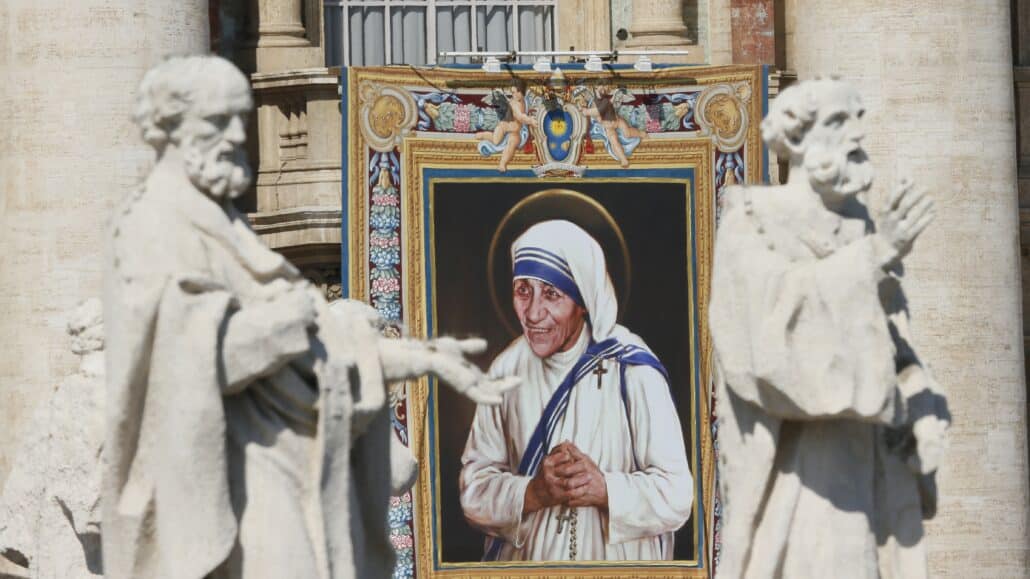Scarcely two years after the death of Mother Teresa in September 1997, the Archbishop of Calcutta at the time, Monsignor Henry D’Souza, requested that Pope John Paul II dispense with the five-year waiting period required before beginning the process of beatification and canonization.
On March 9, 1999, Father Brian Kolodiejchuk, M.C., one of the Missionaries of Charity Fathers, was appointed postulator of Mother Teresa’s cause. The first session of the process took place at St. Mary Parish, in Rippon Lane, Calcutta, a church Mother had attended on numerous occasions, as it was closest to the Missionaries of Charity’s motherhouse.
At the conclusion of the first stage of the process in Calcutta on August 15, 2001, the second stage began, this time in Rome. Between 2001 and 2002, thirty-five thousand pages of documentation were collected, called the “Position.” This, plus the approval in December 2002 of Monika Besra’s miraculous cancer cure (which had occurred on the first anniversary of Mother Teresa’s death), led to Mother Teresa’s beatification at St. Peter Square on October 19, 2003 (World Missions Day).
Blessed Mother Teresa keenly felt Jesus’ thirst for souls. Toward the very end of her life, she wrote a special message entitled “I Thirst” to the Missionaries of Charity Society. In it she wrote: “Only one secret: The closer we come to Jesus, the better we will know his thirst.”
To quench Jesus’ thirst was Mother Teresa’s purpose in founding her religious society. She received this particular “call within a call” during the now famous train ride to Darjeeling on September 10, 1947. This day, known as Inspiration Day, is currently celebrated by the entire Missionaries of Charity Society.
The Missionary Sisters of Charity’s constitutions state: “The general aim of the Society is to quench the thirst of Jesus Christ on the cross for love of souls.”
The reason for our existence is to quench the thirst of Jesus Christ. When he asked for water, the soldier gave him vinegar to drink—but his thirst was for love, for souls, for you and me. This aim made Mother Teresa who she was and motivated her throughout her life to do the things she did. The morning of her death, September 5, 1997, in her last general letter, which she left unsigned, she wrote:
“September 10 is coming very close, and that is another beautiful chance for us to stand near Our Lady to listen to the thirst of Jesus and answer with our whole heart.”
‘Charity Begins at Home’
Since my first contact with Mother Teresa, I have had no other desire than to follow her footsteps as she followed Jesus. From my infancy, I had been longing to have an idea of the love one would feel in the presence of Mary, the Mother of Jesus. I felt this flow of loving goodness when I first glimpsed Mother Teresa in 1976 at her motherhouse in Calcutta. I was waiting in a small courtyard and saw her approaching between the gray buildings, with her bare feet and white sari with the blue border. She passed through a beam of light, and suddenly I understood; my longing was fulfilled.
I remember thinking to myself at that particular moment of grace, “How good it is to be good. I will do anything to have some of this goodness for my life.” I knew that only a true master, possessing wisdom and holiness, is able to pass it on to his or her disciples, and I was eager to learn at Mother Teresa’s school of charity.
Although I had not yet fully grasped it, my life at the time was hindered by a secret wound. At the beginning of my teen years, I had been molested by a priest at a school in Bologna, Italy; this episode left a deep sense of vulnerability entrenched in my life, leaving me totally powerless to help myself.
When I met Mother Teresa, I firmly believed that she would help me to find solutions to this problem and so recover and heal. She did not take the consequences of my abuse away, but by her words and example during my 21 years of association with her, she showed me the royal way of the cross.
Periodically she encouraged me to do heroic acts of total surrender, loving trust, and acceptance. I have not yet learned to do them with the childlike spontaneity and joy she wanted me to have, but I have persevered at her school. In spite of my resistance, she invited me again and again to abandonment to God and confidence in him. She strongly believed that Jesus’ words in the Gospels were true, and she believed that if I remained open and willing, with faith, prayer, and penance, they would come to be realized in my life, too.
Undeniably, Mother Teresa’s spiritual reality was one of an undivided love for Christ, consecrated by the evangelical counsels of poverty, chastity, obedience, and a special fourth vow of wholehearted free service to the poorest of the poor. Mother Teresa, in her desire to give glory to God for the good of any souls, would have wanted to offer her ideal of consecration to anyone ready to listen. The invitation to perfection in the Gospel is, “To anyone who has ears to hear, let him hear!” (Matthew 11:15).
Holiness is not the luxury of the few, but a simple duty for you and for me. So let us be holy as our Father in Heaven is holy. The more you are intimately in love with Jesus, the more holy you will become. The more holy you become, the more you will be a channel of his love, compassion, and presence to the poor. To follow Mother Teresa’s example is a free choice that each individual has to make.
Let me conclude with a quote from Mother Teresa’s letter of December 30, 1994: The Gospel needs to be brought back to the countries falling away from Christianity. Bring the Word to the hungry and thirsting for God, starting with your own family. Charity begins at home.
Young people want to see more than to hear the Word of God. Words, to be true, must be followed by example. Bring yourself and your loved ones back to family prayer. Make your home another Nazareth, where Jesus, Mary, and Joseph can teach you how to live for God, how to belong to him.
The Family that Prays…
Have a special place in your home for the Bible and a picture of the Holy Family. Gather together to pray and share the Word of God, in particular every Sunday. Invite your friends and neighbors whenever you pray together, and forgive each other’ faults as God forgives us…. Keep in mind that the “family that prays together stays together.” This is my missionary invitation to each one of you personally. Be the Holy Father’s lay missionaries, and bring Jesus to each other and to the remotest corners of the earth where he is the least known. God is holy, and he calls you and me to share fully in his holiness.
The call to holiness guided Mother Teresa throughout her life. She said, “Every day I pray, please let my people grow in holiness. I need holy people to offer to God, I don’t need numbers.” That urgency for holiness was what she taught me, by example, by words, by silence.
It is not possible for those of us who claim to be her spiritual children to ignore the heroic promise she made to God: “I will give saints to Mother Church.”








